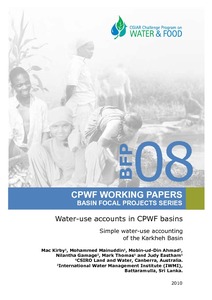Resource information
This paper applies the principles of water-use accounts, to the Karkheh River basin in Iran.
The northern part of the Basin where the Karkheh and its tributaries rise is mountainous, cooler, and wetter. The River spills out on to the hotter, lower semi-arid plains at its southern end. Precipitation, mainly in winter, varies from 400-500 mm in the upper part of the Basin falling to about 230 mm in the lower reaches.
Total water use exceeds rainfall by about 14%, the difference is assumed to be largely pumped groundwater in the upper and middle parts of the basin. Grassland is the most extensive land use and uses about 50% of the total available water. Irrigation, although occupying a smaller area, consumes about 28% of the available water followed by rainfed agriculture, which consumes about 20%.
Plausible figures for the effect of the Karkheh Dam suggest that it will reduce flows downstream of the Dam and the inflow into the Hawr Al Azim marshes.


